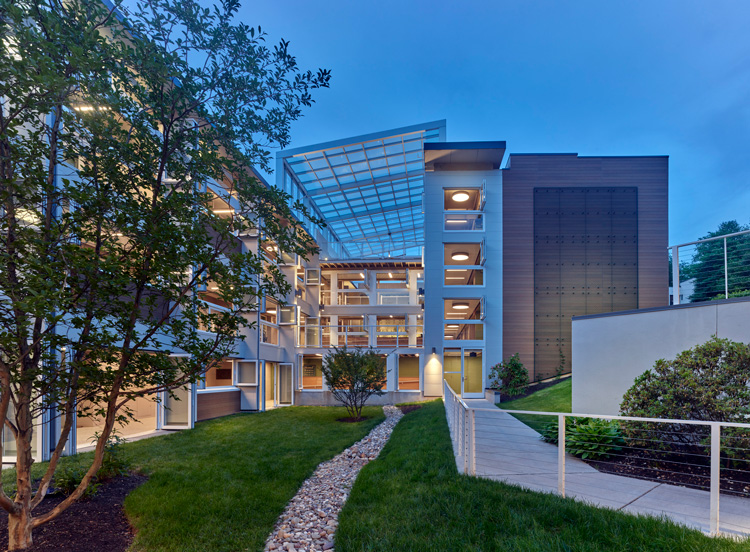By Steven Leone and Richard C. Quinn, Spiezle Architectural Group
Over the past several years, design trends have painted an interesting picture for future life plan communities that stray from what we have seen for decades.
Life plan communities (previously known as continuing care retirement communities, or CCRCs) are nothing new. But with an older population growing and thriving, these life plan communities (LPCs) are shifting away from the traditional continuum of care-based models to a more independent version of health- and wellness-centric focus with little to no care.
This current shift supports strong prospective growth potential, fueled by a growing desire for more modern buildings, larger spaces, amenities and design infrastructure. Nonprofit organizations sponsor approximately 78 percent of LPCs, but this is rapidly changing as for-profit LPCs are growing at triple the rate of nonprofits.
Additionally, with incoming seniors being healthier and more active than their predecessors, the demand is for the continuation of lifestyle, encouraging sponsors to reassess the current design, infrastructure and cost models. Seeing the trend take shape, we made it a central focus of discussion during our annual Aging Forward forum.
Scale/Design
Upgrading and enhancing is a significant priority for LPCs moving forward. Across the country, many LPCs are reassessing their scale as 71 percent of campuses were founded over 30 years ago, with some dating back to the 1800s. The oldest facility traces its roots to 1817.
Some aim to downsize, while others plan to expand by buying adjacent land or acquiring other facilities to increase their physical footprint, thereby needing to add services and amenities for a larger client pool. All plan to update their campuses in some capacity; the approach centers around longevity and innovation.
A factor that changed the course of future LPC design is COVID. New designs must incorporate isolation and observation areas for outbreaks to restrict the spread of illness. The general mindset supported by codes and guidelines is aimed at single-bed residencies vs. shared residences not only for luxury and privacy but also to help mitigate outbreaks. Additionally, mechanical systems are taking a front seat in the design process, including strategies such as bipolar ionization, negative air pressure and fresh air intake.
Amenities/Creation of Community
The new wave of baby boomers coming into LPCs pushes these facilities to alter their priorities. A healthier and more active client base means the traditional care-centric model must shift to vitality models, focused on lifestyle.
With this shift, LPCs need to upgrade and enhance their current amenities in ways that replicate traditional, more authentic living arrangements. Amenity features continue to grow and diversify. We’re seeing the addition of multiple dining venues — including fine dining, bistros and bars — as well as fitness centers, theaters, gardening enclosures, outdoor venues for varied activities, mini-golf, bocce ball and much more.
LPCs are becoming more open and designed to bring a new level of diversity with a core focus on community building. Moving forward, designs will cater to boutique-style communities that feel homey and resort-like at the same time.
These philosophical design shifts are vitally important for designers when envisioning new projects in the LPC space. New residents want creative and exciting experiences, not a care center. Building amenities and spaces that reflect this shift will be significant and challenging in future designs.

Spiezle designed the redevelopment of Cathedral Village, a life plan community in Philadelphia, to maintain an open connection with the site and blurring the lines between interior and exterior spaces through movable walls, overhead doors and folding windows.
Technology
LPCs are in a crucial transformative period, driven by significant changes in consumer behavior and staffing shortages due to the COVID-19 pandemic. Technology is at the center of the transformation.
Residents’ expectations have changed as they’ve become savvier. Residents are now far better connected to family and resources virtually. Wi-Fi connectivity supports telehealth, robotics, security and monitoring in far more detailed and personal ways.
This is only the tip of the iceberg of advancements and new technology requirements for LPCs. We know that the technology we need is available, but now with a better-informed audience, its capabilities are more widely understood and intuitive.
Wellness Focus
New residents want to live in a fully appointed and engaging environment that enhances their minds, bodies and souls. With unique amenities covering residents’ physical engagement, newly designed zen-inspired elements such as meditation rooms, yoga spaces, tea rooms, art galleries, spas and wellness centers are vitally important for the baby boomer populace.
Another trend that has recently grown in LPCs is the incorporation of biophilic design. The concept focuses on the instinctive bond between humanity and other living systems into the architectural planning process. The design focus draws on intrinsic psychology, allowing residents to deeply connect to their surroundings, finding a sense of zen in their environment, thereby elevating their happiness and wellness.
These design trends are being applied throughout the industry nationally, especially in forward-thinking communities. Developers and designers should pay close attention and incorporate these into future projects. Innovation is the best way to ensure any community is appealing to the next generation of retirees.
Steven Leone, AIA, LEED AP, is s seniors housing and healthcare principal at Spiezle Architectural Group Inc. He can be reached at [email protected].
Richard C. Quinn, AIA, LEED AP, is a seniors housing principal at Spiezle Architectural Group Inc. He can be reached at [email protected].

